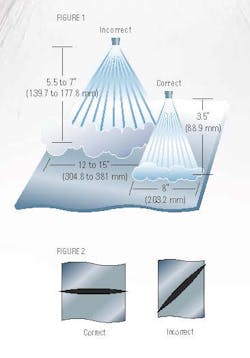On the high-tech side of the market, manufacturers have some exciting options for precision lubrication. AutoJet Lubrication systems equipped with PulsaJet nozzles allow manufacturers to optimize their lubrication spraying operations to perfection—applying exactly what is needed exactly where it is needed, no matter what comes down the line. These systems are able to maintain a consistent coating weight even when line speed changes and can be configured with multiple spray zones to account for varying sheet widths.
It is one of the many advantages to smart manufacturing.
However, not every manufacturer needs such sophistication.
Many small and midsized plants, churning out low-volume, consistent products, lack the infrastructure and resources necessary for sophisticated systems like these, relying instead on manual operations to get the job done.
These plants, however, still require that level of precision to stay viable in the market. If anything, the costs for imprecision in these markets is even more dire.
"In the lubrication world, you run the whole gamut from very large, sophisticated shops with centralized PLC systems, to very small, unsophisticated shops running manually,” explains John White, Senior Product Engineer at Spraying Systems Co.
"A very simple stamping plant might just have a machine or two stamping very small metal parts, only spraying a couple hundred parts and hour," he says. "For these shops, a simple, a low-end system can be a major step forward and, during the long run, could save them a lot of money."
For many of these companies, he explains, lubrication is applied with rollers or even manually, requiring operators to trust their instincts and experience to provide adequate coverage—a risky operation that can carry some heavy costs.
"If you have too much oil on a part when it goes into the press, it can create huge defects in the part," White says. "If there is too little, the die can wear out much quicker, which can be extremely expensive."
The key, he says, is the right amount of lubrication. "If you put too little or too much down on a part or a sheet, that's bad," he says. "You need precision."
To solve this problem, he says, most of these companies don't need a sophisticated process installed.
Rather, "they need a simple system that accurately sprays oil on the sheet or on the part before it moves through the press," he says.
Spraying Systems Co.'s answer to this, he says, is the L210.
AutoJet Model L210 Hydraulic Lubricating System
Ideal for coil or spot lubrication for press tools, drills, and taps in the stamping and forging industries, the L210 is the high precision, low cost system designed for these low-tech shops. "For plants coming from manual operation, without much automation, the best place to start may be a simple system that offers consistent, intermittent spray control," White explains. "They need a system designed to hit the target as it goes by with a specific volume of liquid.
"That," he says, "is the L210 story."
Optimizing Your System
Once the right hardware is installed, the rest comes down to optimization.
- Match the flow rate of the nozzle with the lubricant being sprayed. A spray tip that works well for heavy viscosity lubricants will overspray by nearly 60%when used with a less viscous fluid.
- Match the flow rate of the nozzle to the speed of your conveyor to minimize overspray. Or, use an electrically-actuated nozzle with a spray controller to achieve Precision Spray Control.
- Keep spray height as low as possible to cover the target. To cover a wide target, use a wide-angle spray tip or use multiple nozzles. Do not increase nozzle distance from the target or excessive misting will occur.
- When using multiple spray nozzles to cover a wide target, check the tip’s spray pattern. Some spray tips must overlap the adjacent pattern by 20 to 30% to provide proper coverage.
- Select a spray tip with a narrow angle to cover a narrow target. Do not rotate spray tips to cover a narrow target. This will increase lubricant use by 30 to 70%.











